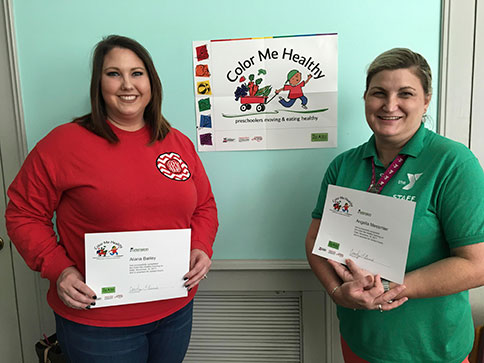
Color Me Healthy is a program developed to reach young children with fun, innovative, interactive learning opportunities that encourage physical activity and healthy eating. The program is designed for children, parents and childcare providers and uses sight, sound, touch and taste to teach children about healthy eating and being active. Color Me Healthy includes classroom activities, songs, games, and imaginary trips, all developed especially for young children.
Color Me Healthy’s goal is to show children that eating healthy and being active is fun! You as the parent will have the opportunity to see and hear Color Me Healthy in action as your children share with you songs and activities from their day. You will receive a monthly newsletter designed for busy parents like yourself. Watch for monthly issues that contain helpful information on eating healthy, being active, quick after-work recipes, as well as ideas to help you and your family be healthy.
The following are excerpts from the November issue of Color Me Healthy Newsletters for parents. The letters gives parenting tips, encourages children and parents to get excited about eating smart and moving more! Just think, every month you receive a free Color Me Healthy Newsletter with valuable information to help you and your children.
Training the trainers
If you are a daycare / childcare provider interested in learning more about the Color Me Healthy Curriculum, contact Carolyn Bivins, Regional Extension Agent at (251) 867-7760 (office) or (251) 533-9073.
A big thanks is extended to Paul Chason, CEO of the Atmore YMCA, for inviting us to conduct Color Me Healthy Train-the-Trainer Program at their facility. The Color Me Healthy Program is sponsored by the Alabama Cooperative Extension System – Escambia County Office and the North Carolina State Extension Service.
Healthy eating tips … encouraging food choices for a healthy diet
* Be patient. Young children may not be interested in trying new foods. Offer new foods more than once.
* Be a planner. Most children need a snack or two in addition to three regular daily meals.
* Be a good role model. What you do can mean more than what you say. Your child learns from you about how and what to eat. Eat meals with your child whenever possible. Walk, run, and play with your child, don’t just sit on the sidelines. A family that is physically active together has lots of fun!
* Be adventurous. At the store, ask your young child to choose a new vegetable or fruit from two or three choices. At home, your child can help you wash and prepare the food.
* Be creative. Encourage your child to invent a new sandwich from three or four healthy ingredients you provide. Try a new bread or whole grain cracker. Talk about what food groups the new snack includes and why it tastes good. Is the snack smooth, crunchy, sweet, juicy, chewy or colorful?
Vegetables seen in the freezer aisle
Fresh vegetables are great, however, sometimes they may not be available, you may not have time to prepare them, or they may be too expensive. Frozen or canned vegetables are great and will get you well on your way to get the fruits and vegetables you need each day. Contrary to popular myth, frozen or canned fruits and vegetables are rich in nutrients. Frozen or canned vegetables are great to have on hand when you are in a hurry or need a quick side dish to round out a meal. Choose frozen vegetables without sauce or butter. Frozen steam-in-the-bags vegetables are convenient. Choose low-sodium canned vegetables or rinse well to reduce sodium.
Try these quick and easy ideas:
* Add frozen peas to tossed salad. Just rinse for a few minutes under water and they are thawed and ready to go.
* Keep canned pineapple or other fruit on hand for quick deserts, toppings for frozen yogurt or to serve on cereal in the morning. Choose fruit that is canned in juice instead or heavy syrup.
* Heat canned green beans in a skillet with a small amount of soy sauce for a slightly different taste.
* Add canned corn into salsa for a chunkier texture.
* Add frozen, thawed chopped broccoli to rice.
You can be active in the fall and winter
It is easier to be physically active in the spring and summer when the weather is nice, but there are lots of outdoor activities you can do in the fall and winter.
Don’t let the cool temperatures discourage you:
* Go bird watching
* Rake leaves
* Stack firewood
* Go ice or roller-skating
* Jump rope
* Play in the snow
* Go for a brisk walk
* Ride bikes
Sharing a recipe
Here is a delightful recipe from the November’s CME Newsletter. This is a recipe for you and your children to prepare together. It is not designed for children to make on their own. Supervision and assistance from an adult are required. Getting your children involved in food preparation will go a long way in encouraging them to try new foods and enjoy eating. Enjoy!
Maple Glazed Carrots
Ingredients
2 cups baby carrots
1/2 cup orange juice
3 tablespoons maple syrup
1 pinch nutmeg
Instructions
1. Pour orange juice into a 4-cup microwave safe dish.
2. Heat 1 minute on high. Add the carrots.
3. Stir to coat the carrots with the orange juice.
4. Cover and microwave 8 to 9 minutes on high.
5. Stir again, and then add the remaining ingredients.
6. Microwave uncovered 2 minutes on high.
7. Stir and check for doneness.
Cook another minute on high if needed.
NOTE: Let your child try a raw carrot while the carrots are cooking. Discuss how different they taste after they are cooked.
